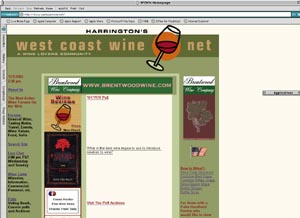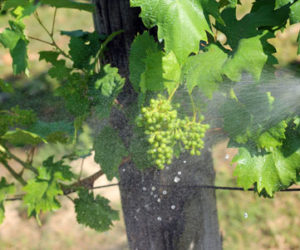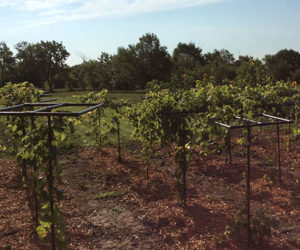
“I am harvesting Pinot Noir and am getting rather strange readings — 22 °Brix, pH of 3.4 and acid at 0.25. The grapes are grown on gravelly (basalt) clay and irrigated. The vines are showing a small amount of water stress. The leaves are green but not growing. The soil has been nutritionally balanced through soil additives, compost and foliar spray twice per season. The temperatures here in southern Oregon averages approximately 86 °F (30 °C) during the growing season, but the night-time lows are in the high 40s to low 50s °F (9 to 11 °C) because we are on the edge of a large river. This is a new vineyard and it is the second year that the acid has been low.”
Wes responds:
Pinot Noir is my specialty, so hopefully we can figure out what’s going on here. Harvesting ripe Pinot Noir at 3.4 pH seems perfectly fine to me, but the 22 degrees Brix implies to me that the flavors will not be rich, fruity and spicy. To me, 22 °Brix is too low of a sugar content to make delicious and balanced Pinot Noir. I pick my Pinot Noir between 23.5 and 24.5 °Brix, which usually “soaks up” in the fermenters to around 25 °Brix.
The really freaky thing about your situation is the acid level. I am assuming you mean that the acid level is 2.5 grams per liter, which is extraordinarily low. While pH is the measure of hydrogen ion activity in solution — wine in this context — it does tend to represent a rough estimation of acidity. I would think that the normal range of acidity in Pinot Noir at 3.4 pH would be from 5 to 7 grams per liter, more than double what seems to be in your juice. My gut feeling is that your lab work is faulty or you misread the results.
If you are doing your own lab work, I suggest you buy the standard lab apparatus to be able to do titrations with (fresh) sodium hydroxide and phenolphthalein. If you don’t feel comfortable in the lab, send it to a professional lab for analysis. I like to use a wine analysis company called Vinquiry (update: now named Enartis), whose main office is located in Windsor California.
There may be labs closer to your home town. To find out, call a winery that you patronize and ask to speak to the winemaker or enologist and pick their brain about local, affordable labs in your area.
Back to your problem: You suggest that last year’s wine was lacking in acidity as well, and I suspect that it is obvious in the wine’s mouthfeel and flavor. The problem is that adjusting 2.5 grams per liter to 5 grams per liter total acidity in the must prior to fermentation is going to take your pH down to close to 3.0. I suspect the wine might prove too tart by the addition of tartaric acid. Taste the grapes, the juice and the wine and use your palate to decide if the fruit is sweet enough and delicious enough to make good wine. Pay special attention to the acidity, to ensure it is ample to make the wine refreshing and structured. Often times, a winemaker uses their sensory evaluation to guide their winemaking, and when your nose or mouth senses a problem or a lack of balance, send the juice to the lab to double-check your suspicions. Trust your nose and your mouth; I suspect your laboratory acidity numbers are incorrect.
The faulty numbers could have come from your home wine-lab chemicals being older than their suggested shelf life. Ensuring that your winery chemicals are fresh each year will increase your chances of getting accurate results. Old NaOH solution can give incorrect results such as these. Without testing the normality of the solution, your results cannot be guaranteed accurate. Best bet: Buy your chemicals from a reliable laboratory supply store and keep them fresh.

“I have over one hundred Seyval grape vines and I have a problem with wasps infesting the grapes and sucking the juice out of them. I’ve used sevin, malathion, traps and other sprays for fruit vines. Nothing seems to work. What do you suggest?”
Wes responds:
Wasps are a tricky problem. If you truly want to get rid of the pests, you will have to do some serious investigation and out-think those nasty stinging bugs. By the time that the wasps are actually “eating” the ripe grapes, there is nothing you can do to control the problem. Chemical applications on the vines or the surrounding areas are usually ineffective because wasp nests are well hidden. There may be a way to physically bar the wasps from entering the vines’ fruiting zone, by using very fine-mesh nets over the vines. However, make sure you aren’t blocking too much sun from the vines, or making the canopy more humid or shaded. The key is to find and eliminate wasp nests before they become numerous — and before the grapes are ripe enough to be a food source. One of my favorite references, “Grape Pest Management,” put out by the University of California, suggests doing “wasp battle” (finding and eliminating nests) at night with a flashlight covered with red cellophane as a safety precaution. Wasps are much less active at night, and the red light should be invisible to them, giving you the advantage of safety and stealth.
To make a long story short, wasps are a difficult problem to solve. Finding nests early in the season and destroying them is key. Keeping the fruit healthy will also discourage them from eating it. There is no documented record of either wasps or bees “biting” through grape skins to get at the sweet juices inside. They generally seek tiny cracks caused by birds, fungus or other insects, and widen those cracks to feed on ripening grapes. Spraying the vines or the grapes is not a good idea because you may poison your wine. Instead, you have to root out the source, the nests, if you want to see any real control at all.

“I was wondering if you know of any Websites that would provide information concerning the current grape- growing season — specifically concerning the quality of grapes growing in different regions of California and when the growers expect to harvest various kinds of grapes.”
Wes responds:
I know of no Website that exclusively publishes this information regularly during harvest, but there are good sources for harvest information. Lots of growers and winemakers in California (including myself) frequent www.westcoastwine.net. In my estimation, this is the best Internet community for learning about West Coast wines and viticulture, and for getting answers to difficult wine, winemaking or grape-growing questions. For instance, if you were a home winemaker who needed information on when Lodi might be harvesting some Zinfandel, you could post a question on the board and expect some answers back from growers in that area. This Website can get you “instant” answers when you need them with little research. But, as with all things “Internet,” the answers are sometimes neither researched nor subject to peer review or fact checking. With that said, I have found the West Coast Wine Net folks to be thorough and trustworthy in their responses. West Coast Wine Net is a free Website and open to anyone who wishes to participate and follow their guidelines for posting. (The guidelines are simply to be polite and as accurate as possible.) Other great sources of harvest information are the major trade publications that are published for the vineyard and wine business such as Wine Business Monthly (www.winebusiness.com). The last of these seems to have the most comprehensive and up-to-date harvest information from around the country. These publications are also doing a better job of covering viticulture and winemaking in smaller, lesser-known grape-growing regions around the United States.
Jim (near the Columbia River, Washington) asks:
“One idea in vineyard floor management I’ve read about is to use grasses and other seeded plants to avoid erosion during winter and to ‘feed’ the soil. I’ve also read that I shouldn’t cultivate the soil. Will there be any impact if I mow our cover crop but do not turn or disc the material back into the soil?”
Wes responds:
You’ve brought up two excellent points about cover crops, which are a great, inexpensive way to keep a home vineyard thriving and producing. A cover crop is created by allowing a mix of native and seeded plants to flourish in the vineyard during vine dormancy to renew the soil’s organic matter and to protect against erosion. It is generally inexpensive, as late fall and early winter rains usually make irrigation unnecessary. Seeding the middle of your vine rows after harvest can be a great way to manage your soil’s health and to keep vineyard hillsides from eroding. Cover crops are generally used in temperate areas where snow will not accumulate and where temperatures will not hamper the winter growth of plants. They are also used where grasses, legumes, vetches and the like can grow during the winter months. Some cover crops are maintained throughout the growing year, but most go to seed and die off before the summer in regions where summer rainfall is limited. In general, cover crops are seasonal, and not commonly irrigated.
Cover crops are a great means of supplying, creating and maintaining adequate amounts of organic matter in the soil, which will keep the vineyard soil healthy and productive. Why is organic matter in your soil important? Organic matter improves the dirt’s tilth (condition of the soil as it relates to plant health), allows water to penetrate deeper, and allows the soil to be more friable (easily broken up). As organic matter breaks down, it will provide nitrogen and other macro- and micronutrients to the vines. Nutrients sourced from organic material are generally more “exchangeable” or usable to the vines than synthetic fertilizers, and are released slowly over many years. Organic matter (mowed or decaying cover crop) will also feed soil microorganisms, which will result in a healthier soil ecosystem. This is turn will moderate vine growth and may help vines to resist disease pressure.
There are really two reasons that vineyards plant a cover crop. If either of these two functions interest you and would help your vineyard, planting a cover crop may be advisable. The first function of cover crop is to control erosion. Annual barley and rye grasses (at 60–90 pounds of seeds per acre) are good choices for erosion control. So are annual, self-seeding grasses that grow quickly, such as Blando brome, and Zorro annual fescue (at 10 pounds of seed per acre). The other major function of cover crop is to add nutrients to your vineyard from decomposing organic matter. If your vineyard needs a little more vigor (from a deficit of nitrogen), try growing some vetch (at 50 pounds of seeds per acre) or clover (at 10–20 pounds per acre). Vetch and clover do a good job of increasing nitrogen levels in a vineyard without the addition of chemical fertilizers.
You mention that the source you read suggests that tilling or cultivating the soil may not be such a great idea. First, you should know that you do not need to bury the cover crop into the soil for it to have a beneficial impact on the vineyard. In fact, the opposite might be true. Cultivating, discing, tilling and the like disturbs the balance of slow organic decomposition. Allowing the cover crop to naturally decompose into the “virgin” soil is a much more effective — although slower — way to get the full benefit of your cover crop.
With this in mind, I suggest allowing your cover crop to grow from late fall to spring and allow it to go to seed before mowing. Then allow the mowed material and the dying plants to decompose naturally in the vine rows to improve your vineyard soil. Mow the cover crop at budbreak, as a clean vineyard floor will have less chance of frost damage in spring. Cold air moves downhill like water, and a clean (mowed) vineyard floor does not restrict this movement of cold air. Lots of tall grasses and other tall plants will restrict the downhill movement of cold air, and increase the chances of frost damaging the young fruit on the vines.




